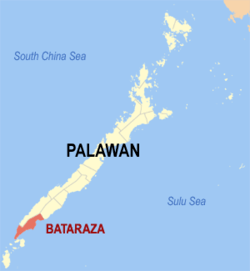Bataraza
| Bataraza | ||
|---|---|---|
| Municipality | ||
| Municipality of Bataraza | ||
| ||
 Map of Palawan with Bataraza highlighted | ||
.svg.png) Bataraza Location within the Philippines | ||
| Coordinates: 8°40′N 117°37′E / 8.67°N 117.62°ECoordinates: 8°40′N 117°37′E / 8.67°N 117.62°E | ||
| Country |
| |
| Region | Mimaropa (Region IV-B) | |
| Province | Palawan | |
| District | 2nd district | |
| Founded | January 1, 1964 | |
| Barangays | 22 (see Barangays) | |
| Government [1] | ||
| • Type | Sangguniang Bayan | |
| • Mayor | Abraham M. Ibba | |
| • Electorate | 37,873 voters (2016) | |
| Area [2] | ||
| • Total | 726.20 km2 (280.39 sq mi) | |
| Population (2015 census)[3] | ||
| • Total | 75,468 | |
| • Density | 100/km2 (270/sq mi) | |
| Time zone | UTC+8 (PST) | |
| ZIP code | 5306 | |
| PSGC | 175305000 | |
| IDD : area code | +63 (0)48 | |
| Climate type | Tropical climate | |
| Income class | 1st municipal income class | |
| Revenue (₱) | 174,584,940.17 (2016) | |
| Native languages |
Molbog Palawano language Tagalog | |
Bataraza, officially the Municipality of Bataraza, is a 1st class municipality in the province of Palawan, Philippines. According to the 2015 census, it has a population of 75,468 people.[3]
The municipality was named after Datu Bataraza Narrazid, a locally influential Muslim chieftain and father of the town's first mayor and former mayor of Brooke's Point, then Datu Sapiodin Narrazid. Bataraza was part of the municipality of Brooke's Point until 1964 by the virtue of Philippine RA 3425.[4]
Main industries of Bataraza includes farming, fishing, and nickel mining and processing.
Geography
Bataraza is located on the southernmost tip of Palawan Island, approximately 225 kilometres (140 mi) from Puerto Princesa City and about five to six hours by land. It has total land area of 957 km².
Bataraza is situated some 775 km (480 mi) south-west of Manila, between roughly 8.3 and 8.75 degrees latitude north of the equator. It stretches approximately 80 kilometres (50 mi) in north-easterly to south-westerly direction along the Sulu Sea, from the Malis River to Cape Buliluyan in the south. On the western side, it extends up to Wangly River.
It is bounded in the east by the Sulu Sea, in the west by a great mountain range, extending from Mount Mantalingahan (the highest peak in the province) to Mount Malitub, which serves as the divider between Bataraza and Rizal, and in the south-west by the South China Sea. Two large crocodiles were recovered here and were taken to Crocodile Farm in Puerto Princesa City.
Barangays
Bataraza is politically subdivided into 22 barangays:
Rio Tuba is one of the populated barangays of Bataraza and known for its nickel mineral reserves. The primary mine site of Rio Tuba Nickel Mining Corporation is located within its jurisdiction.
Demographics
| Population census of Bataraza | ||||||||||||||||||||||||||||||||||
|---|---|---|---|---|---|---|---|---|---|---|---|---|---|---|---|---|---|---|---|---|---|---|---|---|---|---|---|---|---|---|---|---|---|---|
|
| |||||||||||||||||||||||||||||||||
| Source: Philippine Statistics Authority[3] [5] [6] [7] | ||||||||||||||||||||||||||||||||||
In the 2015 census, the population of Bataraza was 75,468 people,[3] with a density of 100 inhabitants per square kilometre or 260 inhabitants per square mile.
References
- ↑ "Municipality". Quezon City, Philippines: Department of the Interior and Local Government. Retrieved 31 May 2013.
- ↑ "Province: Palawan". PSGC Interactive. Quezon City, Philippines: Philippine Statistics Authority. Retrieved 12 November 2016.
- 1 2 3 4 Census of Population (2015). "Region IV-B (Mimaropa)". Total Population by Province, City, Municipality and Barangay. PSA. Retrieved 20 June 2016.
- ↑ "Bataraza" (PDF). Provincial Government of Palawan. Archived from the original (PDF) on 17 April 2012. Retrieved 22 November 2012.
- ↑ Census of Population and Housing (2010). "Region IV-B (Mimaropa)". Total Population by Province, City, Municipality and Barangay. NSO. Retrieved 29 June 2016.
- ↑ Censuses of Population (1903–2007). "Region IV-B (Mimaropa)". Table 1. Population Enumerated in Various Censuses by Province/Highly Urbanized City: 1903 to 2007. NSO.
- ↑ "Province of Palawan". Municipality Population Data. Local Water Utilities Administration Research Division. Retrieved 17 December 2016.
